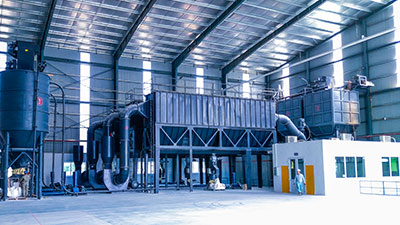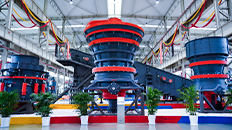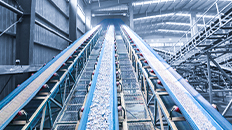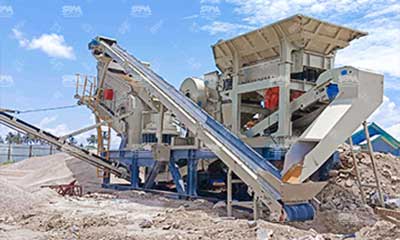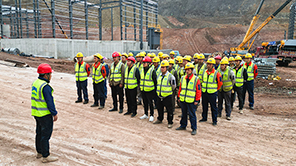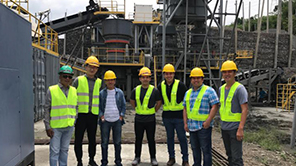Summary:Effective crushing is a fundamental step in the extraction and processing of non-ferrous metal ores, as it significantly influences the efficiency of subsequent processing stages.
The mining and processing of non-ferrous metal ores play a crucial role in the global economy, providing essential materials for various industries, including electronics, construction, and transportation. Effective crushing is a fundamental step in the extraction and processing of these ores, as it significantly influences the efficiency of subsequent processing stages. This article provides an in-depth examination of the crushing process for non-ferrous metal ores.

Definition of Non-Ferrous Metals
Non-ferrous metals are those that do not contain significant amounts of iron. These metals are known for their resistance to corrosion, high conductivity, and lightweight properties. Common non-ferrous metals include:
- Aluminum
- Copper
- Lead
- Zinc
- Nickel
- Tin
Types of Non-Ferrous Metal Ores
Non-ferrous metal ores are naturally occurring minerals from which non-ferrous metals can be extracted. Some common types include:
- Bauxite: The primary ore for aluminum.
- Chalcopyrite: A significant copper ore.
- Galena: The principal ore for lead.
- Sphalerite: The main ore for zinc.
- Laterite: Often a source of nickel.
The Importance of Crushing in Ore Processing
Crushing is a critical process in the extraction of non-ferrous metals from their ores. It involves breaking down large ore bodies into smaller, manageable sizes, which facilitates more efficient processing. The main objectives of crushing include:
- 1. Size Reduction: Reducing the size of the ore to improve the efficiency of subsequent processing stages, such as grinding and flotation.
- 2. Liberation of Minerals: Ensuring that valuable minerals are liberated from the surrounding gangue material.
- 3. Facilitating Transport: Smaller particle sizes are easier to transport and handle during processing.
Types of Crushers Used in Non-Ferrous Metal Ore Processing
Several types of stone crusher are employed in the crushing of non-ferrous metal ores, each with specific applications and advantages.
1. Jaw Crusher
Description:
Jaw crusher is one of the most common types of crushers used in mining. They operate by compressing materials between two jaws—one fixed and one movable.
Applications:
Primary Crushing: Ideal for breaking down large ore bodies into smaller pieces.
High Capacity: Suitable for high-throughput operations.

2. Cone Crusher
Description:
Cone crusher utilize a rotating cone within a fixed bowl to crush materials. They are known for their ability to produce fine aggregates.
Applications:
Secondary and Tertiary Crushing: Effective for producing smaller particle sizes.
Versatility: Can handle a variety of materials, including hard and abrasive ores.
3. Impact Crusher
Description:
Impact crusher use high-speed impact forces to break materials. They are particularly effective for softer ores.
Applications:
Aggregate Production: Suitable for producing high-quality aggregates.
Recycling Operations: Commonly used for processing construction and demolition waste.
4. Hammer Crusher
Hammer crusher utilize rotating hammers to crush materials. They are effective for soft to medium-hard ores.
Crushing Process for Non-Ferrous Metal Ores
The crushing process for non-ferrous metal ores typically involves several stages:
1. Feeding
The ore is fed into the crusher using a conveyor system or grizzly feeder. Proper feeding ensures efficient operation and reduces wear on the equipment.
2. Primary Crushing
In this stage, large blocks of ore are crushed into smaller pieces. Jaw crushers are commonly used for this purpose due to their ability to handle large volumes.
3. Secondary and Tertiary Crushing
The crushed ore is further reduced in size using cone or impact crushers. This stage aims to liberate valuable minerals from the gangue.
4. Screening
After crushing, the material is screened to separate finer particles from larger ones. This step ensures that only the desired size is sent for further processing.
5. Stockpiling
The crushed and screened ore is then stockpiled for transport to the next processing stage, which may include grinding, flotation, or other methods of extraction.
Factors Influencing the Crushing Process
Several factors can impact the efficiency and effectiveness of the crushing process for non-ferrous metal ores:
1. Ore Characteristics
The physical and chemical properties of the ore, including hardness, abrasiveness, and moisture content, can affect the choice of crusher and operational parameters.
2. Crusher Design and Configuration
The design and configuration of the crusher, including the type of crushing chamber and the size of the crushing elements, can influence performance.
3. Operational Parameters
Parameters such as feed rate, crusher speed, and closed-side setting (CSS) must be optimized for maximum efficiency.
4. Maintenance and Wear Management
Regular maintenance and monitoring of wear on crusher components are essential to ensure consistent performance and minimize downtime.
Technological Innovations in Crushing
1. Automation and Control Systems
Advancements in automation have led to the development of sophisticated control systems that enhance the efficiency and reliability of crushing operations.
Remote Monitoring: Operators can monitor equipment performance in real time, allowing for proactive maintenance and optimization.
Automated Adjustments: Modern crushers can automatically adjust parameters based on real-time data.
2. Energy-Efficient Designs
Innovations in crusher design focus on improving energy efficiency. Features such as variable frequency drives (VFDs) allow for better control of energy consumption.
3. Hybrid Technologies
The integration of hybrid technologies, such as combining traditional crushers with electric or hydraulic systems, offers improved flexibility and efficiency in operations.
4. Advanced Materials for Crusher Components
Research into advanced materials for crusher components aims to enhance durability and reduce wear. This development can lead to longer-lasting equipment and reduced maintenance costs.
The crushing of non-ferrous metal ores is a critical process in the mining industry, influencing the efficiency of subsequent processing stages and overall production. Understanding the types of crushers, the crushing process, and the factors that affect performance is essential for optimizing operations.



